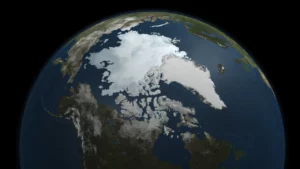
The Arctic is captured in this 2010 visualization using data from NASA’s Aqua satellite. A new study quantifies how climate-related processes, including the melting of ice sheets and glaciers, are driving polar motion. Another study looks at how polar meltwater is speeding the lengthening of Earth’s day. (Credit: NASA’s Scientific Visualization Studio)
Days on Earth are growing slightly longer, and that change is accelerating. The reason is connected to the same mechanisms that also have caused the planet’s axis to meander by about 30 feet (10 meters) in the past 120 years. The findings come from two recent NASA-funded studies focused on how the climate-related redistribution of ice and water has affected Earth’s rotation.
This redistribution occurs when ice sheets and glaciers melt more than they grow from snowfall and when aquifers lose more groundwater than precipitation replenishes. These resulting shifts in mass cause the planet to wobble as it spins and its axis to shift location—a phenomenon called polar motion. They also cause Earth’s rotation to slow, measured by the lengthening of the day. Both have been recorded since 1900.
